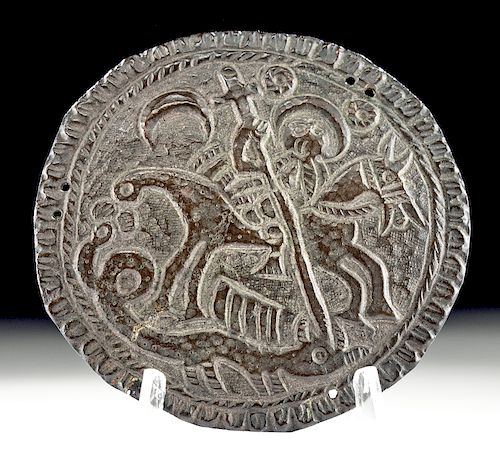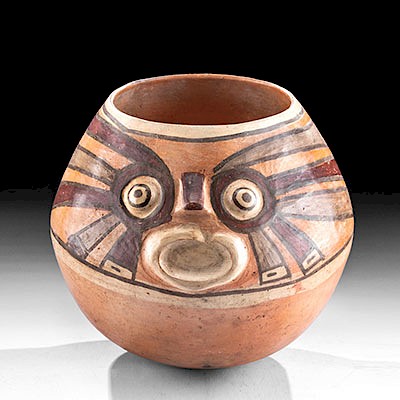Medieval European Bronze Bracteate - St. George
Lot 50
About Seller
Artemis Gallery
686 S Taylor Ave, Ste 106
Louisville, CO 80027
United States
Selling antiquities, ancient and ethnographic art online since 1993, Artemis Gallery specializes in Classical Antiquities (Egyptian, Greek, Roman, Near Eastern), Asian, Pre-Columbian, African / Tribal / Oceanographic art. Our extensive inventory includes pottery, stone, metal, wood, glass and textil...Read more
Categories
Estimate:
$800 - $1,200
Absentee vs Live bid
Two ways to bid:
- Leave a max absentee bid and the platform will bid on your behalf up to your maximum bid during the live auction.
- Bid live during the auction and your bids will be submitted real-time to the auctioneer.
Bid Increments
| Price | Bid Increment |
|---|---|
| $0 | $25 |
| $300 | $50 |
| $1,000 | $100 |
| $2,000 | $250 |
| $5,000 | $500 |
| $10,000 | $1,000 |
| $20,000 | $2,500 |
| $50,000 | $5,000 |
| $100,000 | $10,000 |
| $200,000 | $20,000 |
About Auction
By Artemis Gallery
Dec 5, 2019
Set Reminder
2019-12-05 10:00:00
2019-12-05 10:00:00
America/New_York
Bidsquare
Bidsquare : Ancient / Ethnographic - Holiday Edition
https://www.bidsquare.com/auctions/artemis-gallery/ancient-ethnographic---holiday-edition-4710
What to give this holiday season? Ancient & Ethnographic Art of course! Our special Holiday auction features hundreds of unique finds from all over the world. Artemis Gallery info@artemisgallery.com
What to give this holiday season? Ancient & Ethnographic Art of course! Our special Holiday auction features hundreds of unique finds from all over the world. Artemis Gallery info@artemisgallery.com
- Lot Description
Northern Europe, later Medieval period, ca. 13th to 15th century CE. A beautifully preserved cast bronze bracteate, probably a pilgrim's badge, depicting St. George atop his horse, slaying a worm-like dragon. He holds a massive broadsword and a crescent moon shines overhead upon the scene. Six tiny piercings around the sides - in three pairs - allowed this bracteate to be worn. Although St. George, a soldier of Cappadocian Greek origin, had been popular in Europe for several centuries prior to this time period, the story of him slaying the dragon seems to have originated in Georgia in the 11th century and only reached Europe in the 12th century, and was popularized by the Archbishop of Genoa, Jacobus da Varagine, in his collection of hagiographies, the "Golden Legend". Today, many people associate St. George with England. His legend became popular there following his feast day's promotion to a major festival after Henry V's victory at Agincourt in 1415. Many pilgrim badges and bracteates were produced after that. Size: 2.45" W (6.2 cm)
Provenance: ex-Suzanne Artuner, New Jersey, USA, acquired in 1998; gifted by mother Frances Artuner in 1995 who had owned in Belgium since the 1960’s
All items legal to buy/sell under U.S. Statute covering cultural patrimony Code 2600, CHAPTER 14, and are guaranteed to be as described or your money back.
A Certificate of Authenticity will accompany all winning bids.
We ship worldwide and handle all shipping in-house for your convenience.
#137073Very tiny losses along the edges, otherwise in great condition with a smooth, very dark green patina and great preservation of motifs.Condition
- Shipping Info
-
All shipping is handled in-house for your convenience. Your invoice from Artemis Gallery will include shipping calculation instructions. If in doubt, please inquire BEFORE bidding for estimated shipping costs for individual items.
-
- Buyer's Premium



 EUR
EUR CAD
CAD AUD
AUD GBP
GBP MXN
MXN HKD
HKD CNY
CNY MYR
MYR SEK
SEK SGD
SGD CHF
CHF THB
THB













